Great bento box makers: A visit to Hakoya in Ishikawa, Japan
In April, I had the opportunity to pay a visit to one of my favorite Japanese bento box makers. Hakoya (Tatsumiya K.K.) is located in Kaga Onsen, a quiet town in Ishikawa prefecture, Japan, on the Japan Sea side of the main island of Honshu. Kaga Onsen is known for two things: its hot springs ('onsen' means hot springs in Japanese), and fine lacquerware. Founded right after the end of World War II by a refugee from burnt out Tokyo, Hakoya specializes in the manufacture of plastic dinnerware using the traditional, labor-intensive methods used for wooden lacquerware. For the last couple of years they've been concentrating more and more on bento boxes. If you have been making bentos for any length of time, or just looking at the bento boxes that are available, you have probably encountered the beautiful boxes made by Hakoya.
If you've never compared a Hakoya box to the cheaper plastic bento boxes, you might wonder why they can cost 2-3 times or more. Once you've handled one and seen the quality, it is quite obvious. And the way in which they are made is really impressive. While they are plastic, they are not just spit off some assembly line. Hakoya does not have a big factory; their boxes are made by about 30 small subcontractors or shitauke gyousha, skilled artisans who work with small, specialized equipment.
For instance, the deep, lacquered look of their more traditionally designed boxes is achieved by applying multiple layers of food-safe lacquer. The color is not just flat, since it's applied individually. Here is one of the small workshops, where a mother assists her son, who's airbrushing each box with precision.

Here you can see how deep and rich the layers of colors are. Unless you hold it in your hands it is difficult to tell it apart from lacquered wood.
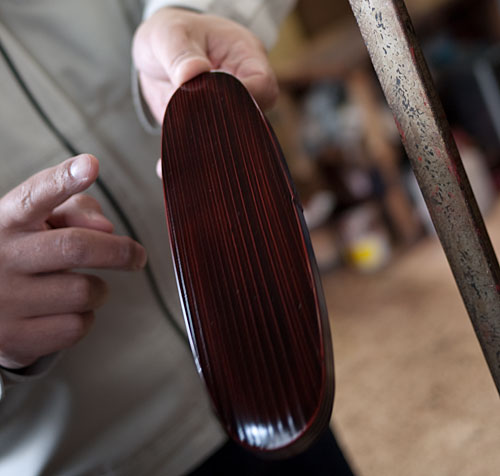
Here's a rack of finished boxes, ready to be put in a special kiln for drying. It's hard to imagine this is a 'just' plastic.
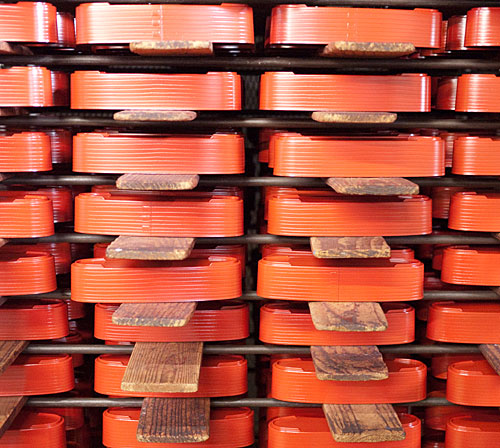
The colorful, sometimes complicated designs on the boxes are silkscreened. Here is Mr. Eno, who is a makie-shi or master silkscreen craftsman, at work. He cuts the screens himself; each color requires its own screen. He's been a makie-shi for more than 35 years, and his workshop is basically the front room of his house. His wife assists him there, mixing colors and so on.

Here are some finished lids. It's hard to see from the photo, but parts of the flower design have some irridescent color that is slightly raised, adding texture and substance to the design. If there's even a tiny flaw, it doesn't make it out of Mr. Eno's workshop.
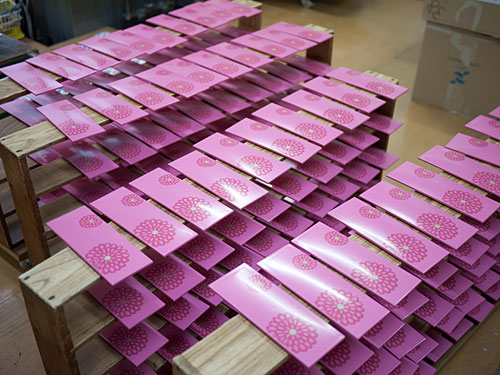
Here are some of the Hakoya products displayed in their showroom. These brightly colored, modern ones are a fairly new line.

These gorgeous traditional design boxes are really tactile. They look almost as good as wooden lacquerware, and are much more practical.

Here are some boxes that are silkscreened with a woodgrain pattern that looks just like wood. You can only tell it's not wood when you pick it up.
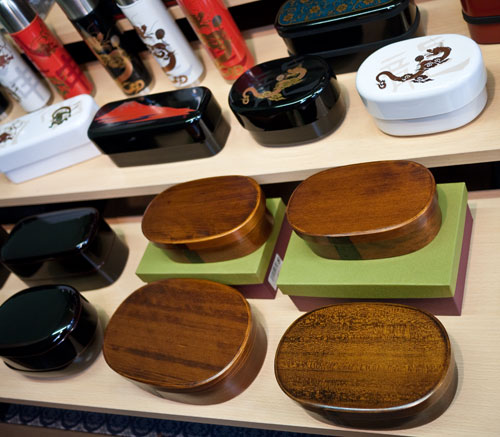
You may have seen these kokeshi doll shaped boxes on the various bento seller sites. They are silkscreened in Mr. Eno's workshop in fact, using a special press that can print precisely on rounded objects. Aren't they adorable?

I loved these onigiri boxes, printed with typical onigiri fillings. (I did actually buy a set later on at a store and they're now in my collection ^_^)
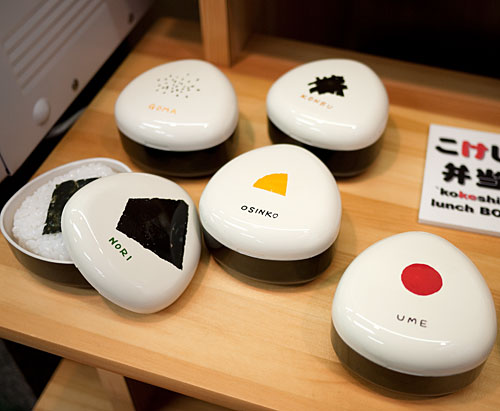
I also loved the '70s-retro vibe of these flower pattern ones. Hakoya mostly does original designs (rather than say, licensed images from other companies). It's really nice to see the mix of traditional and modern colors and designs.

I asked Mr. Saikan, managing directory of Hakoya, what the trends were in bento boxes. He said that in terms of functionality, they are moving towards making most of their boxes totally microwave-safe, by using silicone for flexible elements and so on (currently most of their boxes are only microwave safe if you remove the upper and inner lids). Colorful 'pop' colors are popular, but traditional designs continue to sell. His company is always trying to stay ahead of their less expensive competitors. He said, and rightly so I believe, that once holds one of their boxes in their hands and compares it to a cheaper model, the difference in quality is obvious.
To me, the way Hakoya operates is quite typical of a fine quality Japanese company. Skilled tasks are done by skilled, experienced artisans, with great attention to detail. Everyone I met had obvious pride in what they produced. It was really lovely to see.
Many thanks to Mr. Keiichi Saikan of Hakoya for showing us around all day, as well as to the artisans we met. Merci beaucoup to Thomas Bertrand of Bento&co for the introduction also!
- Hakoya web site (Japanese)
[Update: Here finally is the next Great Bento Makers article: Yoshinobu Shibata Shoten in northen Akita. Enjoy!]
If you enjoyed this article, please consider supporting this site by becoming my patron via Patreon.
